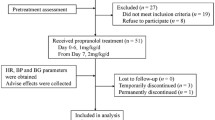Abstract
Objectives
To evaluate laboratory and radiological features of hemangiomas in childhood in addition to efficacy and safety of propranolol as a first-line treatment of complicated hemangiomas retrospectively.
Methods
The files of 60 patients who were diagnosed as capillary hemangioma were evaluated retrospectively. Fourteen children with complicated hemangiomas treated with propranolol were analysed, in terms of side effects, efficacy and duration of treatment.
Results
These fourteen patients (23 %) were treated with propranolol because of ulcerated, infected and/or deep seated localisations. The duration of treatment with propranolol were between 3 and 12 mo (median: 6 mo). Bronchospasm was observed in one patient during treatment. Except for two patients, all of them responded to propranolol treatment with limited side effects.
Conclusions
The present results support that propranolol is safe and effective treatment choice for complicated infantile hemangiomas, because of minimal side effects and encouraging response rates (80 %). In addition, the authors suggest that routine cranial radiological imagings might not be necessary for hemangiomas without any neurological symptoms.

Similar content being viewed by others
References
Léauté-Labrèze C, Dumas de la Roque E, Hubiche T, Boralevi F, Thambo JB, Taieb A. Propranolol for severe hemangiomas of infancy. N Engl J Med. 2008;358:2649–51.
Zimmermann AP, Wiegand S, Werner JA, Eivazi B. Propranolol therapy for infantile haemangiomas: Review of the literature. Int J Pediatr Otorhinolaryngol. 2010;74:338–42.
Starkey E, Shahidullah H. Propranolol for infantile haemangiomas: A review. Arch Dis Child. 2011;96:890–3.
Price CJ, Lattouf C, Baum B, McLeod M, Schachner LA, Duarte AM, et al. Propranolol vs corticosteroids for infantile hemangiomas: A multicenter retrospective analysis. Arch Dermatol. 2011;147:1371–6.
Schwartz RA, Sidor MI, Musumeci ML, Lin RL, Micali G. Infantile haemangiomas: A challenge in paediatric dermatology. J Eur Acad Dermatol Venereol. 2010;24:631–8.
Sans V, de la Roque ED, Berge J, Grenier N, Boralevi F, Mazereeuw-Hautier J, et al. Propranolol for severe infantile hemangiomas: Follow-up report. Pediatrics. 2009;124:e423–31.
Schiestl C, Neuhaus K, Zoller S, Subotic U, Forster-Kuebler I, Michels R, et al. Efficacy and safety of propranolol as first-line treatment for infantile hemangiomas. Eur J Pediatr. 2011;170:493–501.
Manunza F, Syed S, Laguda B, Linward J, Kennedy H, Gholam K, et al. Propranolol for complicated infantile haemangiomas: A case series of 30 infants. Br J Dermatol. 2010;162:466–8.
Bertrand J, McCuaig C, Dubois J, Hatami A, Ondrejchak S, Powell J. Propranolol versus prednisone in the treatment of infantile hemangiomas: A retrospective comparative study. Pediatr Dermatol. 2011;28:649–54.
Fraley DS, Bruns FJ, Segel DP, Adler S. Propranolol-related bronchospasm in patients without history of asthma. South Med J. 1980;73:238–40.
Conflict of Interest
None.
Role of Funding Source
None.
Author information
Authors and Affiliations
Corresponding author
Rights and permissions
About this article
Cite this article
Özyörük, D., Zengin, E. Propranolol Treatment of Complicated Hemangiomas. Indian J Pediatr 81, 368–370 (2014). https://doi.org/10.1007/s12098-013-1125-5
Received:
Accepted:
Published:
Issue Date:
DOI: https://doi.org/10.1007/s12098-013-1125-5




